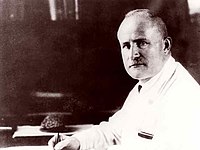
Tänään 3:44
YLE:n yöradiossa kysyttiin, mille teorialle Julian Huxley-niminen tutkija, YK-virkailija ja tieteiskirjailija perusti FOLIOHATUN idean, jonka tehtävä oli "torjua telepatia-aaltoja"
Julian Huxley.
Satun tietämään asian. Tässä on taustalla jonkilainen varoitus tai pila, asia lienee ol-lut korkeissa tiedepiireissä hyvin tunnettu, josin muualla vähemmän, sillä EEG aivo-sähkökäyrän tulkintaa pohdittiin, mistä voisi olla kyse. Laitteen keksijän saksalaisen skitsofreenisen psykitrin HANS BERGERIN mukaan ne olivat "telepatia-aaltoja", ja niillä päät kommunikoivat teleppattisesti, kunhan vain ovat riitävän yhdenlaisia, "samaa rotua".
http://en.wikipedia.org/wiki/Hans_Berger
" In 1924, Berger succeeded in recording the first human electroencephalogram (EEG). [8] Filled with doubt, it took him five years to publish his first paper in 1929 which demonstrated the technique for "recording the electrical activity of the human brain from the surface of the head". [9] His findings were met with incredulity and derision by the German medical and scientific establishments. [10] Having visited the EEG laboratory at Jena in 1935, American roboticist William Grey Walter noted that Berger "was not regarded by his associates as in the front rank of German psychiat-rists, having rather the reputation of being a crank.He seemed to me to be a modest and dignified person, full of good humour, and as unperturbed by lack of recognition as he was later by the fame it eventually brought upon him. But he had one fatal weakness: he was completely ignorant of the technical and physical basis of his method. He knew nothing about mechanics or electricity."[11] "
Hänestä on juuri julksitu Kiinassakin populaari kirja.Kyseessä ei ollut mikään "harmi- ton mies", vaan tuleva natsi-Saksan salattu pääideologi, Heinrich Himmlerin kaveri aseelisen natsilaisen kansalaisjärjestön Sturmabteilungin johtajan Ernst Röhmin olkapään takana...
http://hameemmias.vuodatus.net/lue/2013/12/aivosahkokayra-eeg-n-kehittaja-hans-berger-oli-natsijohdon-salattu-paaideologi
Kiinalainen paljastus Bergeristä:
" New Revelations About Hans Berger, Father of the Electroencephalogram (EEG), and His Ties to the Third Reich. "
http://en.wit.findplus.cn/search_list.html?h=articles&db=edb&an=97409409
Veikkaan, että seuraava tämän luokan paljstus tulee keisari, biologi Hirohitosta...
" Foliohattu on alumiinifoliosta tai vastaavasta ohuesta sähköä johtavasta kalvosta tai pienisilmäisestä verkosta valmistettu päähine. Se on myös ihmisen pilkallinen nimitys, jolla viitataan harhaluuloisuuteen, vainoharhoihin tai kiinnostukseen salaliittoteorioista.[1]
Nimitys tulee siitä,että jotkut käyttävät foliohattua suojaamaan aivoja tai käyttäjäänsä muun muassa sähkömagneettisilta aalloilta ajatustenluvulta ja etämielenhallinnalta. Hatun tarjoama suoja ajatustenluvulta ja etämielenhallinnalta on kuitenkin lähinnä kuvitteellinen, sen sijaan foliohattu voi suojata kantajaansa suurtaajuuksisimmilta radioaalloilta. [2] "
http://en.wikipedia.org/wiki/Tin_foil_hat
Origin
The concept of a tin foil hat for protection against interference of the mind was men- tioned in a science fiction short story by Julian Huxley, "The Tissue-Culture King", first published in 1927, in which the protagonist discovers that "caps of metal foil" can block the effects of telepathy.[1]
Over time the term has been associated with paranoia and conspiracy theories. [2] It is often associated with beliefs that tin foil hats prevent mind control by governments , spies, or paranormal beings that employ ESP or the microwave auditory effect.
Scientific basis
Electromagnetic radiation
The notion that a tin foil hat can significantly reduce the intensity of incident radio frequency radiation on the wearer's brain has some scientific validity, as the effect of strong radio waves has been documented for quite some time. A well-constructed tin foil enclosure would approximate a Faraday cage, reducing the amount of (typically harmless) radiofrequency electromagnetic radiation passing through to the interior of the structure. A common high school physics demonstration involves placing an AM radio on tin foil, and then covering the radio with a metal bucket. This leads to a no-ticeable reduction in signal strength. The efficiency of such an enclosure in blocking such radiation depends on the thickness of the tin foil, as dictated by the skin depth, the distance the radiation can propagate in a particular non-ideal conductor. For half-millimetre-thick tin foil, radiation above about 20 kHz (i.e.,including both AM and FM bands) would be partially blocked, although tin foil is not sold in this thickness, so numerous layers of tin foil would be required to achieve this effect. [4]
The effectiveness of the tin foil hat as electromagnetic shielding for stopping radio waves is greatly reduced by it not being a complete enclosure.Placing an AM radio under a metal bucket without a conductive layer underneath demonstrates the rela- tive ineffectiveness of such a setup. Indeed, because the effect of an ungrounded Faraday cage is to partially reflect the incident radiation,a radio wave that is incident on the inner surface of the hat (i.e., coming from underneath the hat-wearer) would be reflected and partially 'focused' towards the user's brain. However the hat may be partially grounded by the conductive properties of the skin with which it contacts.
A study by graduate students at MIT determined that a tin foil hat could attenuate in-coming radiation depending on frequency. At WIFI frequencies - 2.4 GHz is attenua-ted by up to 90 dB; the effect was observed to be roughly independent of the relative placement of the wearer and radiation source.[5] At some microwave wavelengths, the skin depth is less than the thickness of even the thinnest foil. [6]
A belief also exists that tinfoil is a protective measure against the effects of electro-magnetic radiation (EMR). Despite some allegations that EMR exposure has nega- tive health consequences, [7] at this time no link has been established between the radio-frequency EMR that tin foil hats are meant to protect against and subsequent ill health. [8]
In 1962, Allan H. Frey discovered that reception of the induced sounds by radiofre-quency electromagnetic signals heard as clicks and buzzes can be blocked by a patch of wire mesh (rather than foil) placed above the temporal lobe. "
Kommentit